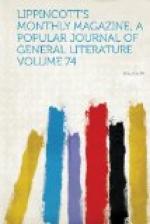any other carriages to be seen in the nineteenth century—heavy,
clumsy, coarsely built and gorgeously painted of the
most flaming scarlet, and largely gilded. They
were drawn by long-tailed black horses covered with
heavy harness richly plated with silver, or something
that looked like it, and driven by a coachman whose
livery, always as shabby as magnificent, was as heavily
laden with huge masses of worsted lace of the kind
that used to be placed on carriage-linings some five-and-twenty
years ago. Two similarly bedizened footmen always
stood on the monkey-board at the rear, who descended
and walked behind His Eminence and his chaplain when
the cardinal left his carriage to get his constitutional.
Ichabod! Ichabod! The glory has departed!
Such cavalcades are no longer to be seen crawling
along the Via Appia, or following His Eminence on
a fine and sunny afternoon about four o’clock
as he walks on the footpath between the Porta Pia and
the Basilica of St. Agnes in search of an appetite
for his dinner. The world will never see such
carriages and such servants any more.
Fuit Ilium!
I thought of the old lines on the “high—mettled
racer,” and of “imperial Caesar, dead
and turned to clay, stopping a hole to keep the wind
away.” To see such splendor reduced to the
service of such vile uses! Yes, as my Italian
friend said, “There go the cardinal’s
wheels,” and it is impossible not to feel sure
that the phenomenon is symbolical of the way the cardinal
is going himself. When an institution, a dignity,
a social arrangement of any sort, has grown to be
purely ornamental, has become so splendid that its
splendor has come to be the essence of it, it will
no longer be able to exist shorn of its splendor,
however much it may in its origin have been adapted
for use rather than for show. The wheels were
heavy, cumbrous and ill put together; they were not
well adapted for the costermonger’s purpose,
and will probably fall to pieces before long.
Their fate is a type of that of their once master.
That ornamental individual, shorn of his ornamental
character, is useless. His
raison d’etre
is gone as entirely as Othello’s occupation
was. And it will probably not be long before
the fate of the cardinal’s wheels overtakes the
cardinal himself.
The second little bit of street incident which recently
occurred to me was in itself less striking, but seemed
to me to symbolize changes of yet higher moment and
wider significance. This time what I saw was in
the Ghetto. Many of my readers probably know what
the Ghetto at Rome is, but untraveled stayers-at-home
may very excusably never have heard of it. The
Ghetto is the Jews’ quarter in Rome—the
district in which they were for many generations compelled
to reside and to be locked in by night, and where
from habit the greater part, especially of the poorer
members of the Jewish community, still live. As
will be easily believed, it is the worst and most
wretched quarter of the city—the lowest




